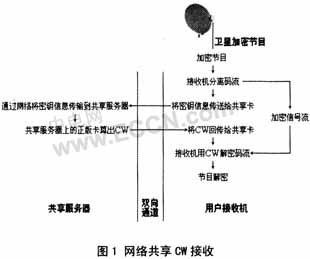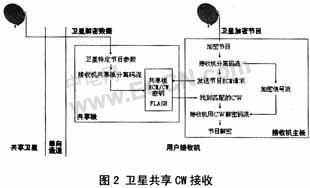1 Introduction
This article refers to the address: http://
The DVB-S digital satellite live broadcast system standard is designed to meet the bandwidth of satellite transponders and the transmission characteristics of satellite signals. Currently, the standard is widely adopted in the domestic satellite digital TV market. The copyright protection is mainly based on the Conditional Access System (CAS). The system principle is to transmit the appropriate Control Word (CW) to the descrambling end to control the entire process of descrambling the program, and only when a certain user is When a program is authorized to be used, the descrambling control word is transmitted to the specific user to implement encryption protection during program transmission. The core of conditional reception is the control of control word (CW) data transmission. In the long-term period, in the satellite encrypted program market based on the DVB standard transmission, there has been a phenomenon that the decrypted information CW control word is transmitted through the Internet and the like, and the satellite program is illegally pirated. In recent years, with the advent of satellite digitalization, such problems have begun to appear in the satellite digital TV market. This method is often referred to as CW sharing.
2 Status
Regular encrypted satellite TV reception requires a machine with a genuine card. Since the price of the genuine card is relatively expensive, the shared service provider can share the CW data on a genuine card to multiple users at a lower price through various channels. Use, and profit from it. In this way, the legitimate rights and interests of satellite operators have been violated, which has also disrupted the normal order of the domestic satellite digital TV market.
At present, there are two CW data sharing channels in the market, illegally receiving encrypted satellite programs, one is to share CW through the network, and the other is to share CW through satellite.
2.1 Network Sharing CW Reception
Network sharing CW receiving As shown in Figure 1, the shared server sends the ECM of the specific encrypted channel to the corresponding genuine card, and the genuine card returns to the shared server after the CW is released, and the shared server transmits the CW to the illegal terminal of the pirated user through the network and other channels. . The shared server sets up multiple card readers and smart cards to provide digital satellite TV for illegal end users to watch different channels.

2.2 Satellite shared CW reception
The basic principle of satellite shared CW reception is shown in Figure 2. It is a newly emerging sharing channel that downloads the entire ECM and corresponding CW data of the shared signal provided from the satellite and stores it in the shared receiver. In the flash memory (FLASH) memory, when the shared receiver receives the encrypted signal, the ECM request is sent to the shared key flash to the genuine card, and the shared key flash sends the matching CW from the genuine card to the receiver, thereby extracting the image. .

3 Reasons for the existence of defects
The reason why CW sharing can happen is mainly from the DVB architecture design itself. In the DVB co-density architecture, the addition of descrambling and encryption and decryption is a separate process: scrambling is done by the front-end scrambling device, descrambling is implemented by the descrambling circuit of the set-top box chip; encryption and decryption mainly complete the de-scrambling control Word protection, after the control word is generated by the scrambler at the front end, the encryption is performed by the encryption machine of the conditional access system (CAS), and the decryption is completed by the smart card provided by the CAS.
In the case of the same density, the boundary of the CAS is defined as "the CW is encrypted at the front end to the terminal smart card to decrypt the CW from the ciphertext into the plaintext", and the process "after decrypting the CW from the smart card and sending it to the set top box through the interface" It is not clearly defined.
In addition, due to the need for standardized production of set-top box chips, set-top box chips are required by default to support different CASs. Under this concept, the CW interface set on the set-top box chip is usually adopted in clear text.
4 six solutions
As can be seen from the previous analysis, CW sharing is a defect in the DVB system. To avoid legal eavesdropping and sharing, the following technical solutions are available:
1. CW encryption communication and set-top box security chip, in which CW encryption communication is protected by encrypted communication between the set-top box and the smart card, the set-top box security chip realizes a secure path from the smart card to the set-top box descrambling circuit, so that the CW plaintext is only in The descrambling circuit appears internally and cannot be acquired externally. This precaution should be said to be a better way at the moment. The shortcomings are: on the one hand, because the CAS manufacturer-related key is embedded in the chip, it has a certain locking property, which may increase the cost of the operator to replace the CAS system. On the other hand, the set-top boxes that have been widely used at present do not use security chips, and these users also have the risk of sharing with CW.
2. Some technical means that the operator can adopt according to the situation, for example, the operator attacks the shared server software vulnerability by sending unhacked instructions, so that the shared server cannot work normally; or by shortening the sending frequency of the data packet, after all, the sharing software user hand There is no complete set of smart card information, sending some strange commands and super long and short commands, which may handle errors, resulting in a large number of shared users sharing CW through the network because the receiving CW is not timely and the black screen is received.
3. Limit the number of reads and writes of genuine cards to increase the cost of shared servers. Limiting the number of ECM decryptions will limit the operation of the shared server. This approach will increase the cost of shared services because more cards are now needed on the server to decrypt all channels.
4. The copyright identification is realized by digital video watermarking, and piracy tracking is realized by video fingerprinting, wherein the digital fingerprint can solve the problem of multi-user sharing piracy. Disable its smart card by identifying rebel users sharing the CW. In order to identify the thief who shares the CW, the CW of different users needs to have certain differences. The solution in this respect is to identify a thief or multiple conspirators by CW fingerprinting and CW dyeing. This technology reduces the pressure on encryption protection and creates a large deterrent to CW-shared thieves.
5. Shorten the CW replacement speed. If the replacement speed is faster than the network transmission delay, the receiver will receive an intermittent signal, or even completely unreadable. Since the ECM data insertion amount is relatively small, and in order to ensure stable viewing in the system design, taking into account the occasional transmission error factor, there are two CW alternate replacement and two to three ECM data replacement CW characteristics.
6. In the development of DVB-S2, it is considered that the data stream and the decoder are transmitted by encryption, and the two ends randomly generate a key for code stream encryption, in order to prevent data from being read from the bus interface to protect copyright. This is especially true for CAS systems if this encryption is applied to the bus signal interface. A similar approach is taken for the data of the CAS interface. Once this is done, the shared user has no way to get the original ECM and CW, and the encryption key for each machine is randomly generated and is different. As a result, shared terminal and server implementations are difficult.
5 Conclusion
CW shares system defects that belong to DVB. In a sense, all CASs currently have this problem, which is a common challenge for all CAS vendors. Solving the problem of control word sharing requires not only the efforts of the CAS provider, but also the support of the set-top box hardware and software environment. The technical solution can increase the cost of piracy for non-profit-oriented sharing enthusiasts, but it cannot prevent well-funded organized groups and companies with profitability. In addition to increasing the cost of cracking R&D, the shared service provider for profit is also required to crack down on illegal activities through legal channels. By obtaining evidence of illegally providing services, the public security organs resorted to the law to crack down on shared service providers.
Our EV home charger is cutting edge EV Charger designed to charge electric vehicles both at residential and commercial locations.
Brief overview:
-
Application: Our EV charger are used to recharge electric vehicles conveniently at home as residential EV chargers, allowing our customers to start their day with a full battery or top up as needed.
-
Type of our electric car charger for home:
- Level 2 Chargers: Our chargers require a dedicated 240-volt circuit and offer significantly faster charging speeds compared to Level 1 chargers. They are the most common choice for residential EV charging.
-
Connectivity: Our modern home EV charging station come with Bluetooth and Wi-Fi connectivity, allowing users to monitor and control charging remotely through smartphone apps, providing convenience and enables users to take advantage of off-peak electricity rates.
-
Cost: The total cost of our electric car charger can be very competitive with high end quality assurance.
-
Benefits: Our EV Home Chargers offer several advantages, including the convenience of charging at home, cost savings compared to public charging stations, and the ability to start each day with a fully charged battery.
-
Environmental Impact: By charging at home,we can reduce our carbon footprint compared to using fossil fuels. Let's contribute to a cleaner environment together!
Ev Home Charger,Ac Ev Charger,Ev Charging Wall Box,Electric Car Charger
EMoreShare International Trade (Suzhou) Co., Ltd , https://www.emoreshare.com